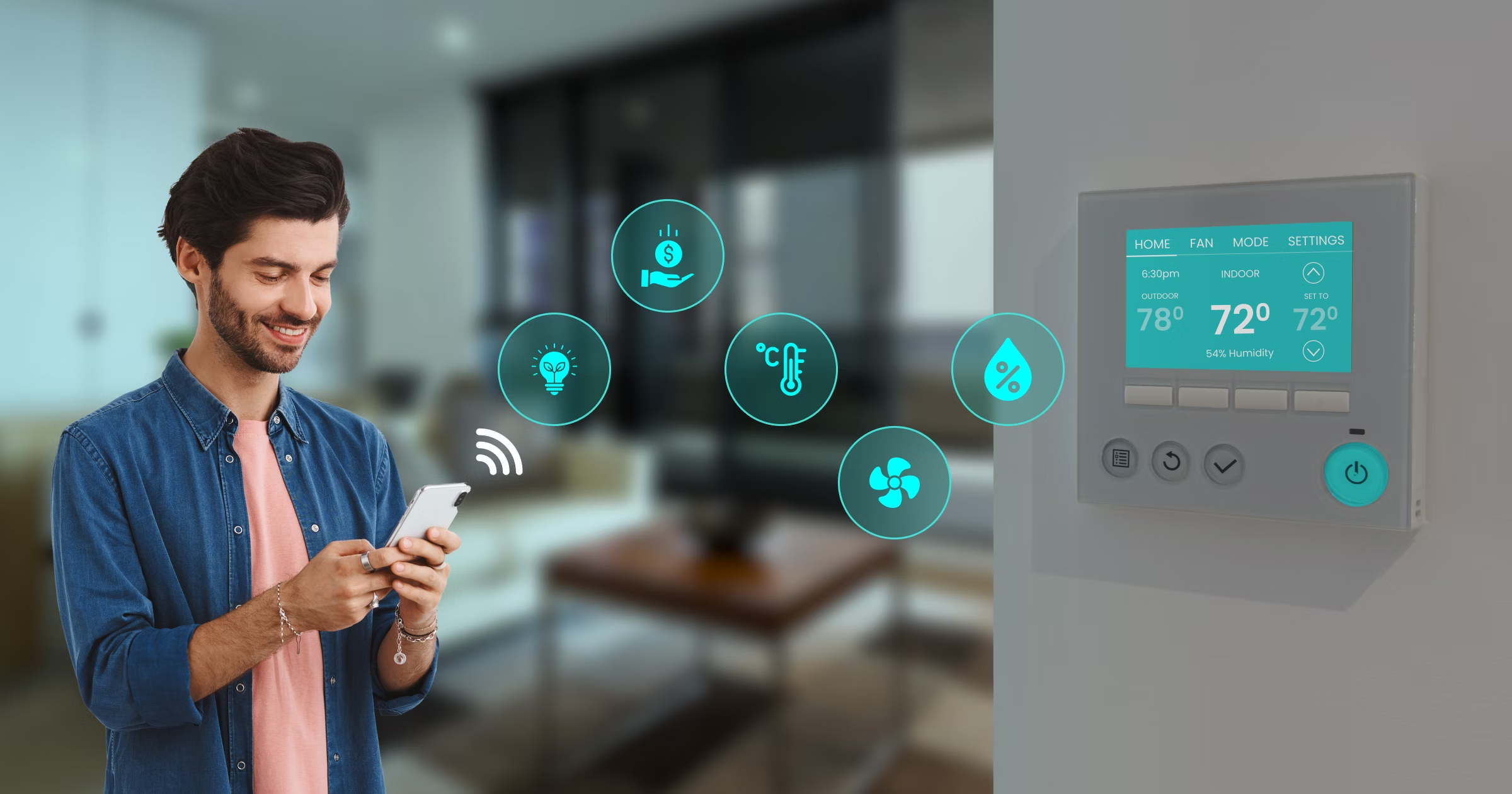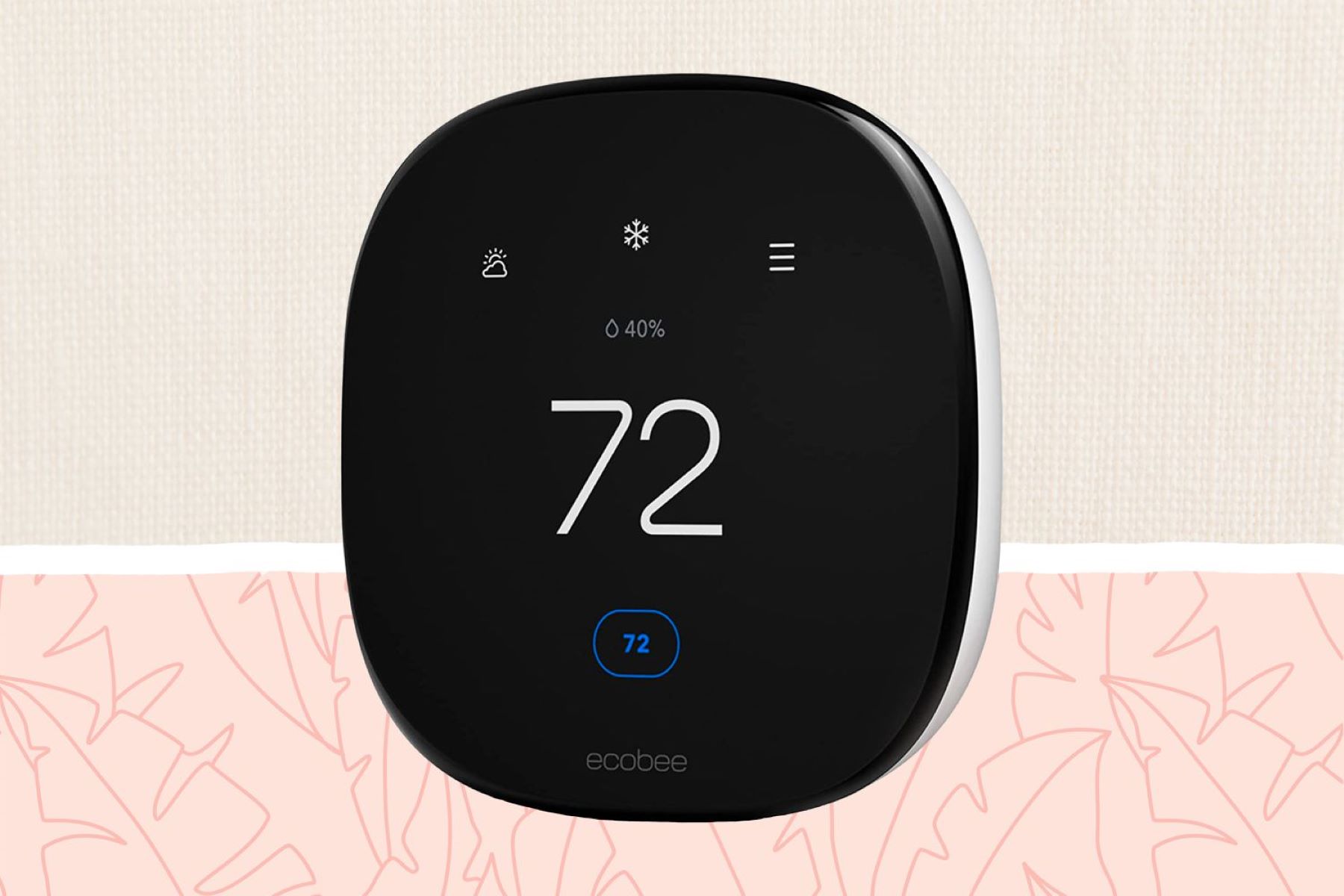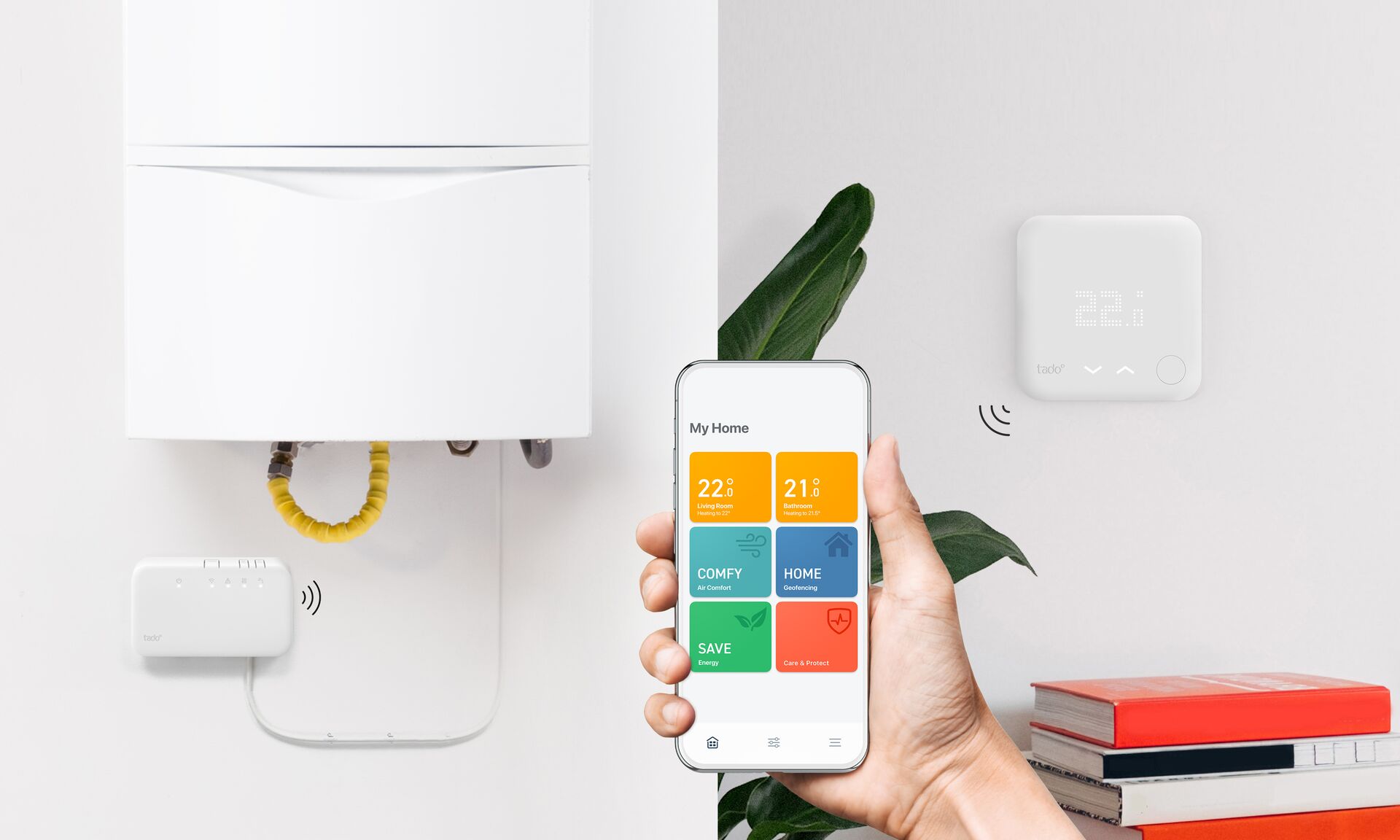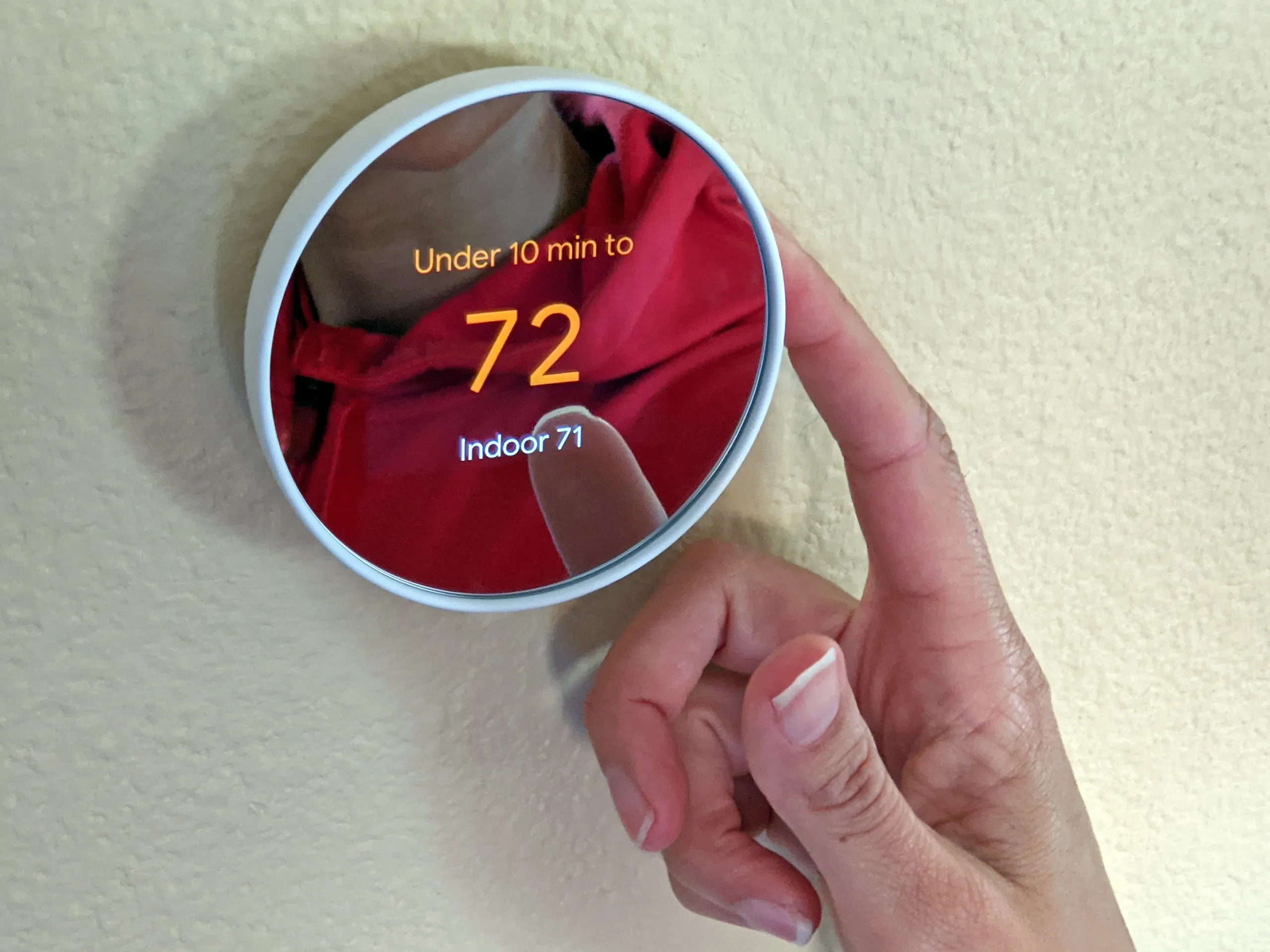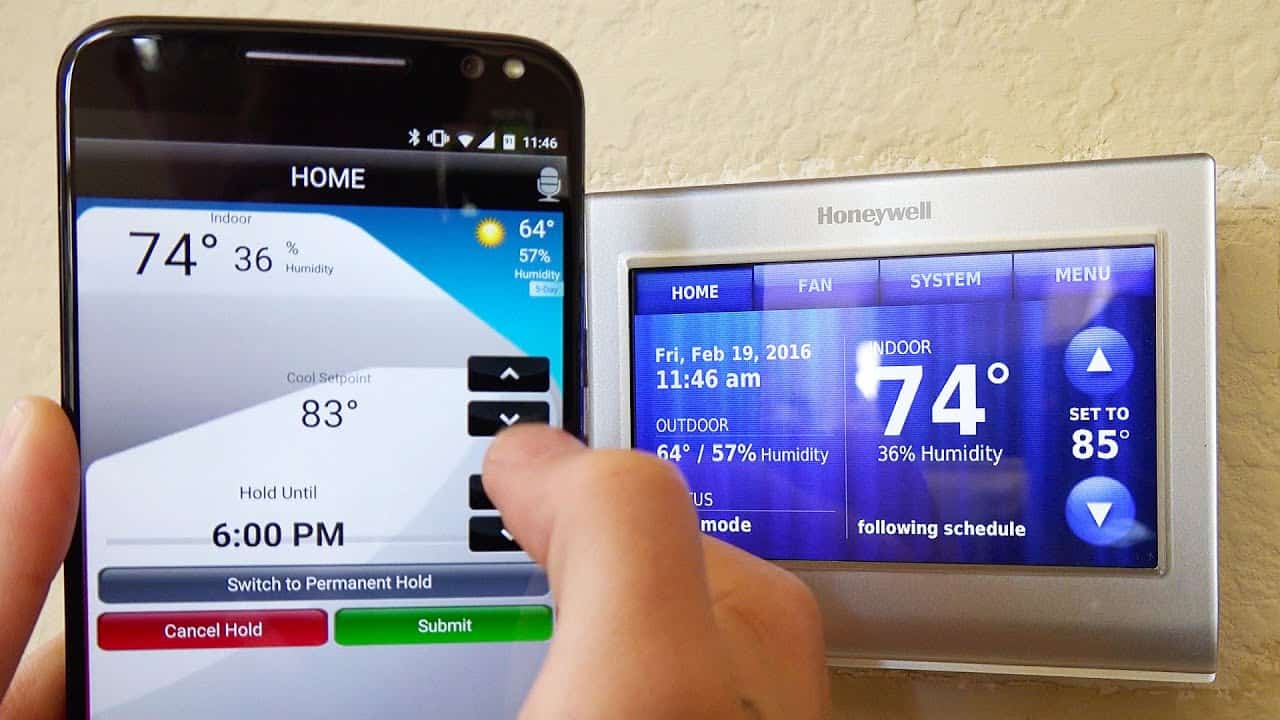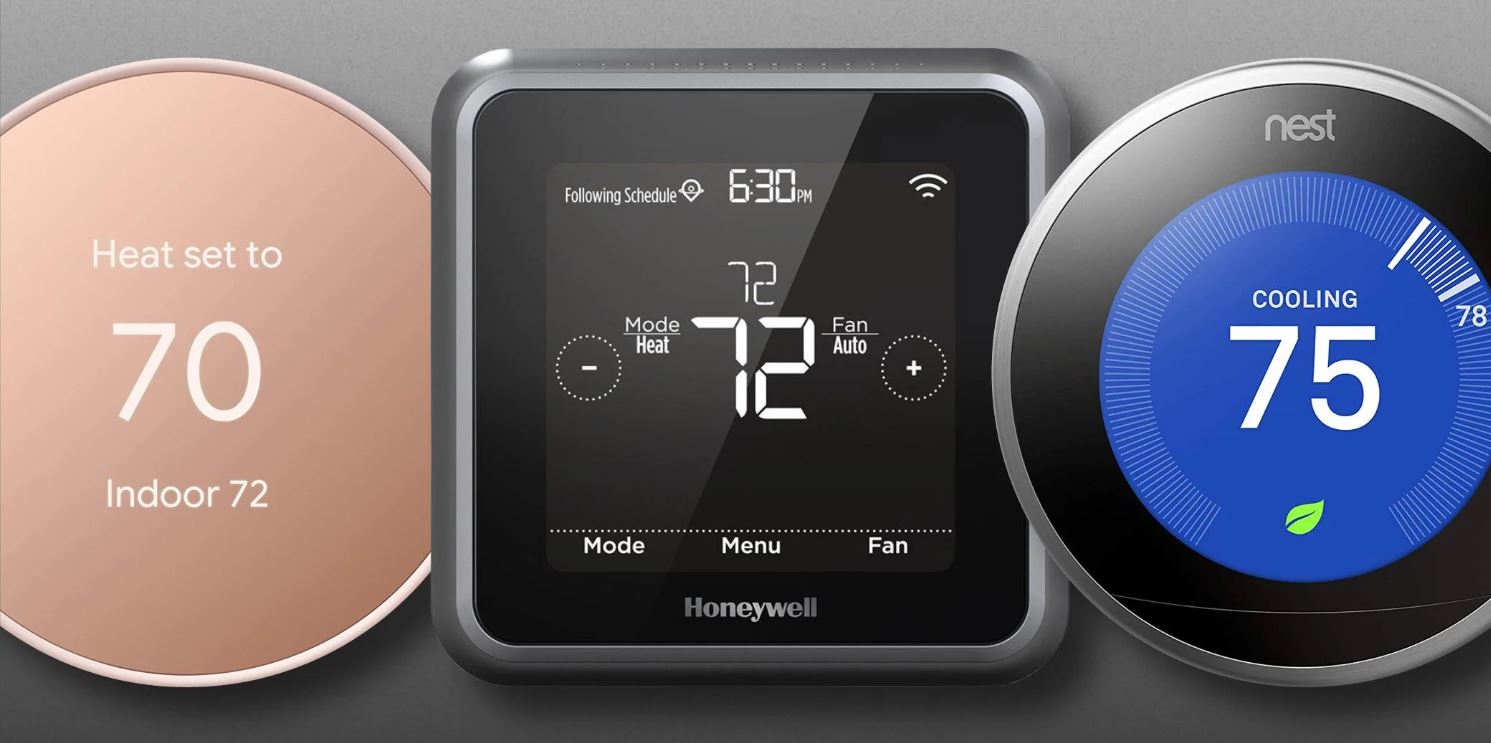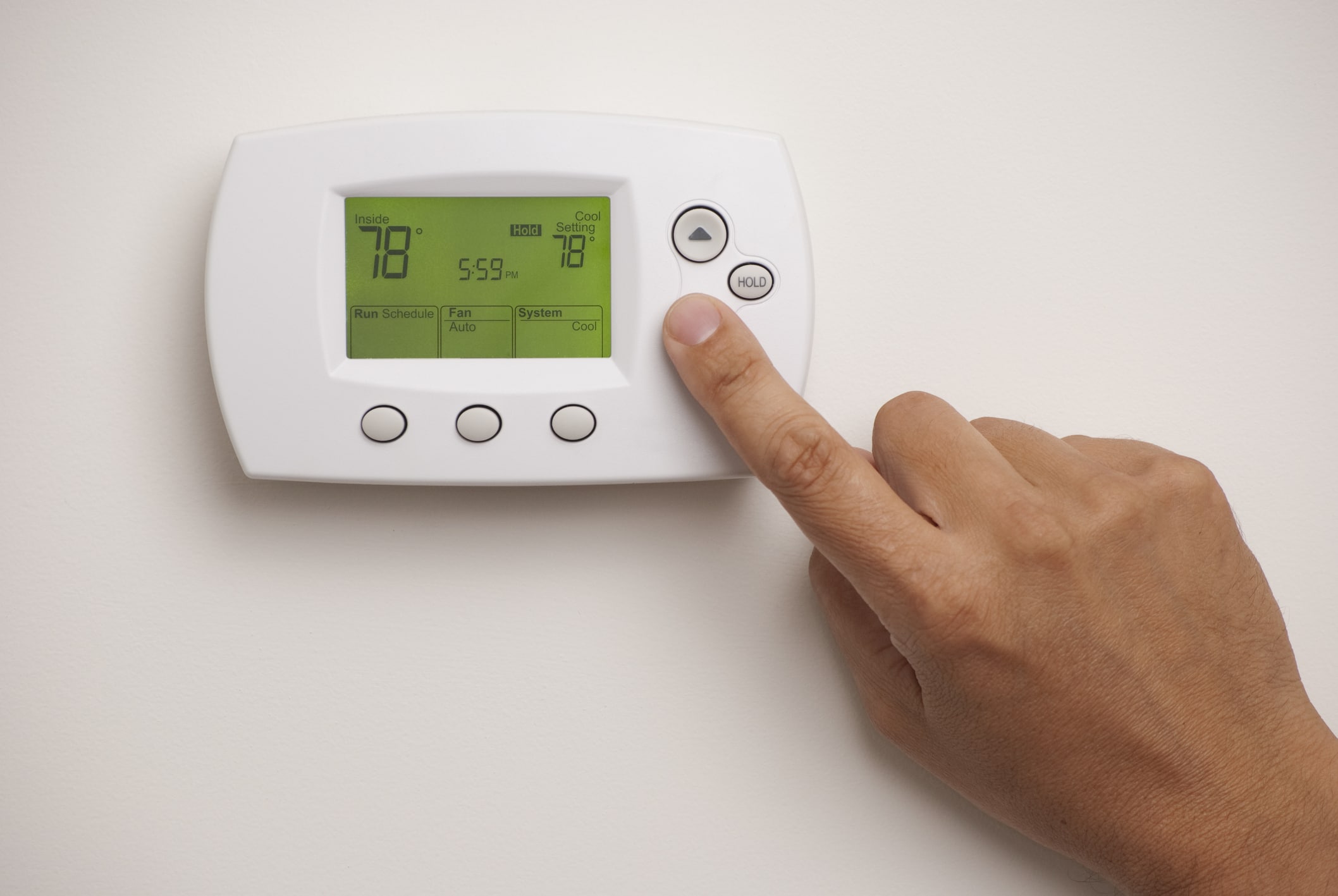### Introduction
Introducing the Smart Thermostat: A Money-Saving Game Changer
Welcome to the world of smart home technology, where convenience and energy efficiency go hand in hand. One of the standout devices in this realm is the smart thermostat. Gone are the days of manually adjusting your thermostat or even relying on outdated programmable options. With a smart thermostat, you can take control of your home’s temperature and significantly reduce your energy usage – and subsequently, your monthly bills.
A smart thermostat is a technologically advanced device that is designed to optimize heating and cooling systems in homes. It is an upgrade from traditional thermostats, which typically rely on simple temperature settings and basic scheduling capabilities. This new generation of thermostats offers a range of cutting-edge features that make them highly intuitive and energy-efficient.
Wondering how exactly a smart thermostat works? It connects to your home’s Wi-Fi network, allowing you to control it remotely using your smartphone or other smart devices. With its built-in sensors and advanced algorithms, it can learn your schedule, detect your presence, and even adjust the temperature based on factors such as outdoor weather conditions. This level of automation and customization leads to optimal comfort while saving you money on your energy bills.
In this article, we will delve deeper into the world of smart thermostats, exploring their benefits, money-saving potential, and how they integrate with other smart home devices. So, if you’re ready to transform your home and embrace energy-efficient living, let’s dive in!
### What is a Smart Thermostat?
Exploring the Concepts and Features
A smart thermostat is a modern-day marvel that revolutionizes the way we control the temperature in our homes. Unlike traditional thermostats, which require manual adjustments, smart thermostats utilize advanced technology to intelligently manage your HVAC system.
At its core, a smart thermostat is a connected device that allows you to control the temperature settings of your home using your smartphone, tablet, or computer. It connects to your home’s Wi-Fi network, enabling you to adjust the temperature from anywhere, at any time. This means that whether you’re snuggled up on the couch or miles away on vacation, you can effortlessly control your home’s climate.
One of the key features of a smart thermostat is its ability to learn your preferences and schedule. By monitoring your usage patterns and habits, it can create a personalized heating and cooling schedule that aligns with your lifestyle. Imagine waking up to a warm house in the morning or coming home to a cool and comfortable environment without lifting a finger – that’s the power of a smart thermostat.
Smart thermostats also incorporate innovative sensors and algorithms to optimize energy usage. They can detect when you’re away from home and adjust the temperature accordingly, ensuring that you’re not wasting energy heating or cooling an unoccupied space. Additionally, some models can even connect to your smartphone’s GPS to automatically adjust the temperature based on your proximity to home.
Another noteworthy feature of smart thermostats is their compatibility with voice assistants and other smart home devices. This means you can effortlessly control your thermostat using voice commands, such as “Hey Google, set the temperature to 72 degrees” or “Alexa, increase the cooling.” Additionally, they can integrate with other smart home devices, such as smart lighting or smart locks, creating a seamless and interconnected living experience.
In summary, a smart thermostat is a cutting-edge device that brings convenience, energy efficiency, and customization to your home’s temperature control. With its advanced features and connectivity options, it offers a level of control and automation that traditional thermostats simply can’t match.
### How Does a Smart Thermostat Work?
Unveiling the Technology Behind the Efficiency
Have you ever wondered how a smart thermostat is able to revolutionize the way we control our home’s temperature? Let’s take a closer look at the technology that powers these intelligent devices.
At its core, a smart thermostat is equipped with multiple sensors that gather data about your home, its inhabitants, and the surrounding environment. These sensors include temperature sensors to measure the current temperature, humidity sensors to monitor the moisture levels in the air, and occupancy sensors to detect whether someone is present in the house. All these data points come together to create a comprehensive understanding of your home’s climate.
Utilizing these sensors, a smart thermostat can adjust the temperature in your home based on a combination of factors. For example, if the temperature outside drops significantly, it can increase the heating to ensure your home remains comfortable. Similarly, if it detects that nobody is home, it can automatically lower the temperature to conserve energy. This dynamic adjustment not only maximizes comfort but also minimizes energy waste.
In addition to sensors, smart thermostats employ advanced algorithms and machine learning techniques to optimize energy usage. These algorithms analyze data such as weather forecasts, historical usage patterns, and user preferences to create a personalized and efficient heating and cooling schedule. Over time, the smart thermostat learns your habits and adjusts its temperature settings accordingly.
Another key feature of smart thermostats is their connectivity. By connecting to your home’s Wi-Fi network, the thermostat becomes accessible via a smartphone app or web interface. This allows you to control the temperature from anywhere, whether you’re in another room or miles away from home. The remote access feature ensures that you can always maintain the perfect indoor climate while saving energy.
Furthermore, smart thermostats can integrate with voice assistants like Amazon Alexa or Google Assistant. This means that in addition to using a mobile device, you can control the temperature by simply using voice commands. Just say the magic words, and your smart thermostat will adjust the temperature as per your request.
In summary, a smart thermostat works by utilizing sensors, advanced algorithms, and connectivity to create a personalized and efficient heating and cooling experience. By constantly monitoring and adapting to your home’s climate and occupancy, these intelligent devices help you save energy and maintain a comfortable living environment.
### Benefits of Using a Smart Thermostat
Unlocking Comfort, Convenience, and Energy Savings
Investing in a smart thermostat can bring a multitude of benefits to your home. From energy savings to enhanced convenience, let’s explore the advantages that come with using a smart thermostat.
1. Energy Efficiency: One of the primary benefits of a smart thermostat is its ability to optimize energy usage. By intelligently adjusting the temperature based on occupancy, outdoor weather conditions, and your schedule, it ensures that you only use energy when needed. This can lead to significant energy savings and lower utility bills.
2. Cost Savings: With the energy efficiency comes cost savings. By reducing your energy consumption, a smart thermostat can help you save money on your heating and cooling bills. Over time, these savings can add up, making the purchase of a smart thermostat a wise long-term investment.
3. Comfort Optimization: A smart thermostat allows you to achieve optimal comfort in your home. With its ability to learn your preferences and create a personalized schedule, you’ll always come back to a comfortable environment. No more waking up to a chilly house or returning home to a stuffy room.
4. Remote Access and Control: Perhaps one of the most convenient features of a smart thermostat is the ability to control it remotely. Whether you’re at work, on vacation, or simply in another room, you can adjust the temperature using your smartphone or other connected devices. This convenience ensures that you always have control over your home’s climate, no matter where you are.
5. Insights on Energy Usage: Many smart thermostats provide detailed insights and reports on your energy usage. You can track how much energy you’re using, analyze patterns, and make educated decisions to further reduce your energy consumption. This awareness empowers you to be more mindful of your energy usage and take steps towards a greener lifestyle.
6. Integration with Other Smart Devices: Smart thermostats often have the ability to integrate with other smart home devices. This means you can create automation routines that sync your thermostat with your smart lighting, door locks, or even your voice assistants. This seamless integration enhances the overall smart home experience and provides a truly interconnected living environment.
7. Environmental Impact: By using a smart thermostat and reducing your energy consumption, you’re making a positive impact on the environment. Lower energy usage means reduced greenhouse gas emissions, helping to combat climate change and promote a sustainable future for all.
Overall, the benefits of using a smart thermostat extend beyond simply controlling your home’s temperature. They encompass energy savings, cost reductions, improved comfort, convenience, and environmental consciousness. So why settle for outdated thermostats when you can embrace the technology of the future?
### Saving Money on Energy Bills
Harnessing the Power of Energy Efficiency
One of the biggest advantages of using a smart thermostat is the potential for substantial savings on your energy bills. By optimizing your home’s heating and cooling, a smart thermostat helps minimize energy waste and keep your costs in check.
1. Smart Scheduling: With a smart thermostat, you have the ability to create a personalized heating and cooling schedule that aligns with your daily routine. You can program specific temperature settings for different times of the day, ensuring that you’re not wasting energy when you’re away from home or asleep. This targeted approach to temperature control can lead to significant energy savings over time.
2. Occupancy Detection: Many smart thermostats are equipped with occupancy sensors that can detect whether someone is present in the home. If the sensors determine that the house is empty, the thermostat can automatically adjust the temperature to conserve energy. This means you won’t be wasting energy heating or cooling an unoccupied space, resulting in noticeable energy and cost savings.
3. Adaptive Learning: Smart thermostats are capable of learning your behavior and preferences over time. They analyze your temperature adjustments, occupancy patterns, and even external weather conditions to adapt and optimize your home’s climate settings. By continually fine-tuning its temperature controls, the thermostat ensures that you’re using energy efficiently and only as needed.
4. Temperature Insights: Some smart thermostats provide insights into your energy usage by showing you how temperature adjustments impact your energy consumption. Through visual graphs and reports, you can gain a better understanding of your heating and cooling patterns and make informed decisions to further reduce your energy usage. This awareness empowers you to actively manage your energy consumption and lower your bills.
5. Geo-Fencing Capability: Certain smart thermostats utilize geo-fencing, a technology that connects your smartphone’s GPS to the thermostat. This allows the thermostat to automatically adjust the temperature based on your proximity to home. For example, when you leave a certain radius of your home, the thermostat can lower the temperature to conserve energy. When you return, it can start heating or cooling your home to a comfortable level. This smart feature ensures that you’re not wasting energy when you’re away and that you come home to a pleasant climate.
By combining these energy-saving features, a smart thermostat can have a significant impact on your energy bills. The ability to optimize your home’s temperature, adjust for occupancy, and learn from your patterns all contribute to reducing energy waste and increasing cost savings.
### Energy Usage Insights and Tracking
Gaining Knowledge and Empowering Energy Efficiency
One of the remarkable features of smart thermostats is their ability to provide valuable energy usage insights and tracking. By giving you a deeper understanding of how your home consumes energy, smart thermostats empower you to make informed decisions and further optimize your energy efficiency.
1. Detailed Reports: Many smart thermostats come with user-friendly interfaces and detailed reports that give you insights into your energy usage. These reports can show you how much energy you’re consuming, both in real-time and historically. They may also display the duration and frequency of heating and cooling cycles, allowing you to identify any energy-wasting patterns.
2. Usage Visualization: Visualizing your energy consumption can be incredibly powerful in identifying areas for improvement. Smart thermostats often present your energy usage data in easy-to-understand graphs and charts. This visual representation helps you grasp patterns and trends, allowing you to make adjustments to reduce energy waste and increase efficiency.
3. Benchmarking: Some smart thermostat platforms enable you to compare your energy usage with similar households or energy-saving targets. By benchmarking your energy consumption against others, you can gain a better perspective on how efficiently you’re using energy. This information can motivate you to make changes and strive for greater energy efficiency.
4. Recommendations: Smart thermostats can provide personalized recommendations to help you save even more energy. Based on your usage patterns, they may suggest adjustments to your temperature schedules or provide tips on how to optimize your settings for maximum efficiency. These actionable recommendations guide you in making changes that can lead to significant energy and cost savings.
5. Tracking Progress: By monitoring your energy usage over time, you can track your progress in reducing consumption and lowering your energy bills. Smart thermostats often provide historical data, allowing you to compare your current usage with previous periods. This tracking feature not only helps you stay motivated but also shows you the tangible results of your efforts towards energy efficiency.
6. Real-Time Insights: Some smart thermostats offer real-time feedback on your energy consumption. They may display the energy usage in kilowatts or provide notifications and alerts when energy usage exceeds certain thresholds. This instant feedback encourages you to make immediate adjustments and take control of your energy consumption in the moment.
By harnessing the power of energy usage insights and tracking, smart thermostats enable you to become more aware of your energy consumption. Armed with this knowledge, you can make proactive changes and take steps towards a more energy-efficient lifestyle.
### Flexible Scheduling and Customization
Tailoring Temperature Control to Suit Your Lifestyle
A key advantage of using a smart thermostat is the flexibility and customization it offers in scheduling your home’s temperature. With smart thermostats, you have the power to create personalized temperature settings that align with your lifestyle and preferences.
1. Custom Temperature Schedules: Smart thermostats allow you to set up custom temperature schedules for different times of the day or week. Whether you prefer a cooler temperature at night for better sleep or higher heat in the morning to wake up comfortably, you can easily program these preferences into your thermostat. This customization ensures that your home is always at the perfect temperature at every hour.
2. Multiple Temperature Zones: Some smart thermostats support multiple temperature zones in your home, giving you even greater control over temperature management. This feature is particularly beneficial if you have different heating and cooling requirements in different areas of your house. Whether it’s a home office, bedrooms, or living spaces, you can set specific temperature settings for each zone, maximizing comfort and energy efficiency.
3. Adaptive Learning: Smart thermostats are equipped with advanced algorithms that learn your temperature preferences and adjust accordingly. As you interact with your thermostat and make manual adjustments, it will remember and adapt to your patterns. Over time, the thermostat will automatically adjust the temperature to meet your desired comfort level without the need for constant manual intervention.
4. Vacation Mode: Going on vacation? Smart thermostats often feature a vacation mode that allows you to set a specific temperature while you’re away. This feature ensures that your home remains at an optimal energy-saving temperature, preventing unnecessary heating or cooling during your absence. Once you’re ready to return home, you can easily adjust the temperature back to your liking using remote access through your smartphone or other connected devices.
5. Manual Overrides: While smart thermostats are designed to automate temperature control, they also allow for manual overrides when you want immediate adjustments. If you’re feeling too hot or too cold, you can simply adjust the temperature manually through your thermostat or smartphone app. This flexibility ensures that you have full control over your home’s climate at any given moment.
6. Smart Adaptations: In addition to customization, smart thermostats can adapt to changes in your routine. For instance, if you typically wake up at 6 am on weekdays but sleep in on weekends, the thermostat can automatically adjust the temperature schedule accordingly. This adaptability ensures that your home’s temperature remains in line with your changing routines and preferences.
With flexible scheduling and customization options, smart thermostats allow you to create a personalized and comfortable living environment. Whether it’s setting different temperatures for different zones or tailoring schedules to your daily routine, these features ensure that your home’s temperature is just the way you like it, all while optimizing energy usage.
### Remote Access and Control
Controlling Your Comfort from Anywhere
One of the standout features of smart thermostats is their ability to provide remote access and control over your home’s temperature. With this convenient capability, you can easily manage and adjust your thermostat settings from anywhere, at any time.
1. Smartphone Control: Smart thermostats connect to your home’s Wi-Fi network, allowing you to access and control them through a dedicated smartphone app. Whether you’re at work, running errands, or on vacation, as long as you have an internet connection, you can effortlessly control your thermostat from the convenience of your smartphone. This level of remote access ensures that you always have control over your home’s temperature, no matter where you are.
2. Temperature Adjustments: Remote access enables you to make immediate temperature adjustments, ensuring your home is always at the desired comfort level. If you’re on your way home and want to arrive to a cozy space, you can increase the temperature before you even step through the door. Alternatively, if you forgot to adjust the thermostat before leaving, you can lower the temperature remotely to conserve energy until you return.
3. Vacation Control: If you’re going on vacation, remote access allows you to manage your thermostat even when you’re far away. You can put your thermostat in vacation mode, setting a specific temperature to maintain while you’re gone. This feature ensures energy efficiency and cost savings during your absence, and you can easily return the thermostat to your preferred settings when you’re back.
4. Real-time Monitoring: Remote access not only allows you to control the temperature settings but also provides real-time monitoring of your home’s temperature and energy usage. You can check the current temperature, track heating and cooling cycles, and stay informed about your energy consumption even when you’re away. This insight helps you make informed decisions and adjustments to optimize energy efficiency.
5. Alerts and Notifications: Smart thermostats often offer alerts and notifications that can be sent directly to your smartphone. For example, if your home’s temperature exceeds a set threshold or if there is a system malfunction, you will receive an alert. These notifications help you stay informed about any issues or irregularities, allowing you to take prompt action and ensure the comfort and safety of your home.
6. Integration with Voice Assistants: Many smart thermostats have voice assistant integration, allowing you to control your thermostat using voice commands. Whether it’s adjusting the temperature, changing schedules, or activating specific settings, you can simply speak to your voice assistant, such as Amazon Alexa or Google Assistant, and it will execute your commands. This hands-free control adds an extra level of convenience to managing your thermostat remotely.
With remote access and control, smart thermostats provide a level of convenience and flexibility that traditional thermostats simply cannot match. The ability to adjust and monitor your home’s temperature from anywhere at any time ensures that you’re always in control of your comfort and energy usage.
### Integration with Other Smart Home Devices
Creating a Seamless Connected Home Experience
A significant advantage of smart thermostats is their ability to seamlessly integrate with other smart home devices. This integration enhances the overall functionality of your home automation system and allows for a more connected and streamlined experience.
1. Voice Assistant Compatibility: Many smart thermostats are compatible with popular voice assistants, such as Amazon Alexa, Google Assistant, or Apple Siri. This compatibility allows you to control your thermostat using voice commands. You can simply ask your voice assistant to adjust the temperature, raise or lower the thermostat, or even check the current temperature in your home. This hands-free control eliminates the need to manually interact with your thermostat and enhances the convenience of managing your home’s climate.
2. Smart Lighting Integration: Integrating your smart thermostat with your smart lighting system can create a more harmonious and energy-efficient home environment. For example, you can set your lights to dim or turn off when the thermostat detects that no one is home, minimizing unnecessary energy consumption. Similarly, you can program your lights to automatically turn on or adjust brightness when the thermostat detects your presence. This integration ensures that your lighting and temperature settings work together seamlessly to enhance comfort and energy efficiency.
3. Smart Window Treatments: Smart thermostats can integrate with motorized window shades or blinds to regulate the amount of sunlight entering your home. By coordinating with the thermostat, the window treatments can automatically open or close based on the temperature or time of day. For instance, during summer months, the shades can close during the hottest part of the day to prevent heat gain and reduce the load on your cooling system.
4. Smart Home Security: Integration with your smart home security system enables your thermostat to work in tandem with other security devices. For instance, if your security system detects a potential breach, the thermostat can automatically adjust the temperature to provide a visual indication of an alarm or to aid in fire suppression. Additionally, the thermostat can coordinate with security cameras, unlocking doors, or activating sirens when necessary.
5. Smart Plugs and Energy Monitoring: Connecting smart plugs and energy monitoring devices to your smart thermostat can provide even deeper insights into your energy usage. By connecting appliances or electronics to smart plugs, you can monitor their energy consumption and track how they impact your overall usage. The smart thermostat can then adjust temperature settings or energy-saving modes based on this detailed information, further optimizing energy efficiency.
6. Whole-Home Automation Platforms: Many smart thermostats can integrate with whole-home automation platforms. These platforms act as a central hub, allowing you to control multiple smart devices, including thermostats, lighting, security systems, and more, from a single interface or app. This centralized control simplifies device management and provides a seamless and cohesive smart home experience.
By integrating your smart thermostat with other smart home devices, you can create a truly connected and efficient living environment. The ability to control and coordinate different aspects of your home automation system ensures that your devices work together harmoniously, creating a more comfortable, energy-efficient, and personalized home experience.
### Conclusion
Embracing the Smart Thermostat for Comfort and Savings
As we delve into the world of smart technology, the smart thermostat emerges as a game-changer in home temperature control. Its advanced features, such as flexible scheduling, remote access, energy usage insights, and integration with other smart devices, elevate the way we manage our homes’ climate.
By investing in a smart thermostat, you can unlock a wide range of benefits. The ability to optimize energy usage and create personalized temperature schedules leads to significant savings on your energy bills. Moreover, the convenience of remote access and control allows you to adjust your thermostat settings from anywhere, ensuring comfort and energy efficiency at all times.
Smart thermostats provide valuable insights into your energy consumption, empowering you to make informed decisions about your usage habits and further reduce your environmental impact. Through their integration with other smart home devices, they create a cohesive and interconnected living experience, merging temperature control with lighting, security systems, and more.
In conclusion, a smart thermostat goes beyond basic temperature adjustments. It is a powerful tool that enhances comfort, improves energy efficiency, and brings convenience to your home. By embracing this technology, you can create a comfortable living environment, enjoy savings on your energy bills, and contribute to a greener future.







